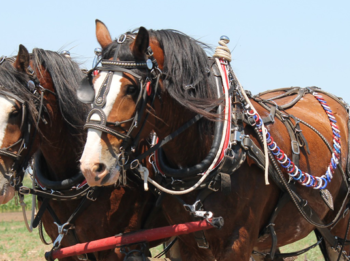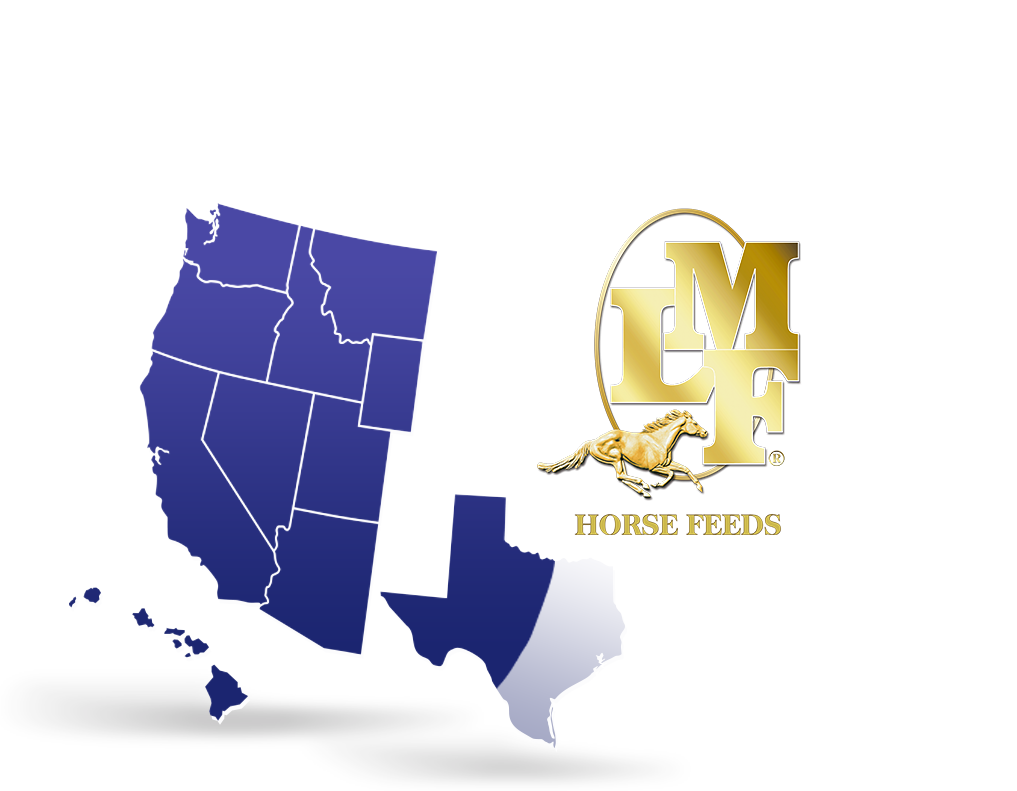Feeding the Mature Draft Horse
In recent years, the popularity and the use of draft horses has increased in the United States. Draft Horses can be categorized into three distinct types, namely Farm, Hitch, and the Pulling horse. The “Farm” horse will weigh around 1500 pounds and stand 16 hands or less. The “Farm” horse is used for a variety of activities and is quite versatile in that it can be used for both driving and riding in a number of activities on the farm. The “Hitch” horse will exceed 17 hands and weigh 1800 pounds or more. The “Hitch” horse is the draft horse version of a show horse. This horse typically pulls carts and wagons in single, pair, unicorn, four, six and eight horse hitches. The “Pulling” horse will vary in height and may weigh from 1600 pounds or less to 1700 pounds or more. These horses are used competitively in weight pulling contests and also in environmentally friendly farming and logging operations.
Much of our knowledge for feeding draft horses originated when draft horses were used as the mechanical power on farms. Traditionally, the farm and pulling horses were fed home grown grains and roughages. Farmers and ranchers often feed what they had on hand. Common feed grains provided to draft horses included oats, corn and rolled barley. These may have been fed with protein and mineral supplements to avoid obvious nutrient deficiencies. Harvested forage that was traditionally fed to draft horses included timothy, alfalfa, grass or alfalfa-grass mixture hay. Grazing on native range, reseeded pastures, and crop aftermath was also typical.
The hitch or show horses used on city carriages and in parades and competition were fed some of the first formulated rations. These rations were designed to enhance hair coat, hoof quality and maintain show condition. These formulated rations included grains, protein supplements and vitamin/mineral fortification. These rations were the front-runners to today’s diets fed to horses.
Modern feeding of draft horses requires an understanding of nutrient requirements according to age, size, stage of reproduction and work. Like light horses (Quarter Horses, Paints, Morgans, etc.), draft horses require a suitable combination of hay, pasture, grain and supplements to meet the nutrient and energy requirements for the type of activity being performed. Energy, or the calorie content of the diet, will vary greatly depending on the activity of the horse. Draft horses will have dramatically different energy requirements depending on speed and duration of work being performed. For example draft horses working at a walk will require less feed than horses working at a trot. Hitch horses performing at a rapid trot with high leg action may require twice the energy. Similarly, horses used in pulling contests will require large amounts of energy to fuel the short bursts of intense work. Energy is the only nutrient that dietary adequacy can be determined by visually looking at the horse. If a draft horse is being fed too much energy (calories) it will gain body weight. On the other hand, if it is being fed less energy than it is expending the horse will loose body weight or condition. Feeding the proper amount of energy will also depend on the rate of metabolism of the draft horse. Generally, draft horses have a very slow metabolism meaning they do not burn excess calories with unnecessary movement. Some horsemen translate their slow metabolism into the phrase easy-keeper, meaning the horse does not require a large amount of feed to maintain condition. However, not all draft horses are easy-keepers. Many of the horses used in show hitches require a tremendous amount of feed to maintain condition. In addition to energy, draft horses require protein, vitamins and minerals. The requirement for each nutrient depends on the physiologic function (pregnancy, growth, lactation, work) of the horse. Therefore, just as with light horse breeds, we can not feed all draft horses the same diet.
Many modern draft horse owners tailor their feeding programs to compliment different climates and geographic locations. These draft horse owners select grain concentrates that not only compliment the horse, but also the geographic region of the country. The following are general feeding guidelines for mature draft horses.
Approximate Feed Consumption
Idle Horses: can maintain body condition on good quality forage such as grass pasture, grass hay, alfalfa hay or grass, alfalfa mixed hay. This is typical when horses aren’t being worked between seasons. Horse should be fed 1.5 to 2 lbs of hay per 100 lbs of body weight along with a low intake, protein, vitamin and mineral pellet.
Light work: horses typically can not maintain body weight without the additional calories provided by grain. Feed 1.5 to 2 lbs of hay per 100 lbs of body weight along with 0.3 to 0.5 lbs of fortified grain per 100 lbs of body weight.
Moderate work: feed 1.25 to 1.5 lbs of hay per 100 lbs of body weight along with 0.75 to 1 lb of fortified grain per 100 lbs of body weight.
Hard work: these horses are typically fed 1.25 to 1.5 lbs of hay per 100 lbs of body weight along with 1 to 1.25 lbs of fortified grain per 100 lbs of body weight.
Defining the amount of work, accomplished daily is relative. It may range from horses pulling an empty wagon in a parade to 8 to 10 hours plowing, haying or logging. The teamsters experience will determine the level of work performed and the necessary modifications to the amount of feed provided to maintain body condition.
As with any horse, the feeding management is critical to maintain proper health. Traditionally, working draft horses would be provided with the majority of their daily grain intake in the morning prior to work and at noon during rest. They would be provided with approximately 25% of the daily forage intake during these two meals. At night, draft horses would be provided with free-choice forage and small amounts of grain. Modern draft horses are typically fed both the grain and forage portion of their diet in two meals provided in the morning and evening. In any draft horse feed operation, several other feeding management practices should be followed:
- Feed horses regularly
- Keep managers free of dust and dirt
- On days off from work, reduce the consumption of grain the night before and during the day off
- Ration changes should be gradual and not abrupt
- Follow the feeding recommendations of commercial prepared concentrates.
- Horses need free access to fresh water
- During the winter, water in the tank should be ice free
- Horses should have free access to salt
- Most draft horses prefer loose salt over block salt
- All horses require vitamin and minerals supplementation to balance deficiencies in hay and pasture
The successful feeding of draft horses requires sound judgment and experience. Many of the feeding recommendations and rations formulated by animal husbandry professors in land – grant universities during the 1900’s form the basic guidelines for feeding draft horses today.
Featuring Guest Writer: Ed Duren, MS, PAS – Professor Emeritus, University of Idaho

Available Across the West.
Distributed throughout the Northwest, Southwest, Hawaii and Texas.
Find a Dealer Near You

